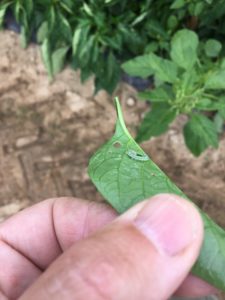Sweet Corn
European corn borer (ECB) adults remain very low, and no map will appear in this edition.
The highest nightly trap catches of ECB for the week ending 8/19/20 are as follows:
| Downer 1 |
| Matawan 1 |
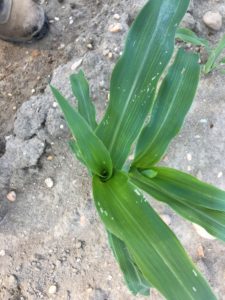
 Fall armyworm (FAW) larval infestations continue at a fairly steady rate, except for coastal Monmouth County, where infestations exceeding 60% were found in whorl and seedling stage sweet corn. This infestation was likely associated with the tropical storm of two weeks ago. FAW could increase dramatically with the arrival of these storms, resulting in significant injury to whorl and even seedling stage corn. Injury from newly hatched larvae shows up as “window panes” or areas where leaf tissue has been eaten down the the lower epidermis (see photo at far left). This injury leads down into the whorl. As larvae gain size, they begin to consume leaf tissue in its’ entirety, creating ragged holes and lots of droppings (see photo at near left). FAW can be tough to manage because it is resistant to synthetic pyrethroid insecticides (IRAC 3A) and because larvae are often covered by their own droppings, making contact with the insecticide more difficult. Treat when 12% or more plants exhibit FAW injury alone, or in combination with ECB injury.
Fall armyworm (FAW) larval infestations continue at a fairly steady rate, except for coastal Monmouth County, where infestations exceeding 60% were found in whorl and seedling stage sweet corn. This infestation was likely associated with the tropical storm of two weeks ago. FAW could increase dramatically with the arrival of these storms, resulting in significant injury to whorl and even seedling stage corn. Injury from newly hatched larvae shows up as “window panes” or areas where leaf tissue has been eaten down the the lower epidermis (see photo at far left). This injury leads down into the whorl. As larvae gain size, they begin to consume leaf tissue in its’ entirety, creating ragged holes and lots of droppings (see photo at near left). FAW can be tough to manage because it is resistant to synthetic pyrethroid insecticides (IRAC 3A) and because larvae are often covered by their own droppings, making contact with the insecticide more difficult. Treat when 12% or more plants exhibit FAW injury alone, or in combination with ECB injury.
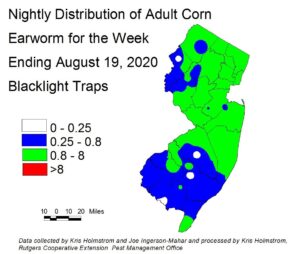 Corn earworm (CEW) moth captures have increased significantly in central and northern New Jersey blacklight traps over the past week. This moderate mid-Summer population poses a significant risk to silking corn. Catches remain somewhat variable (see map at left), with green areas on this map representing a 3-day spray schedule. Note that there continues to be disagreement between blacklight and pheromone trap maps with regard to the southwestern counties. See pheromone trap information below.
Corn earworm (CEW) moth captures have increased significantly in central and northern New Jersey blacklight traps over the past week. This moderate mid-Summer population poses a significant risk to silking corn. Catches remain somewhat variable (see map at left), with green areas on this map representing a 3-day spray schedule. Note that there continues to be disagreement between blacklight and pheromone trap maps with regard to the southwestern counties. See pheromone trap information below.
The highest nightly trap catches of CEW in black light traps for the week ending 8/19/20 are as follows:
| Bellemeade 5 | Lawrenceville 3 | Matawan 2 |
| Morristown 3 | Georgetown 2 | New Egypt 2 |
| Princeton 3 | Hackettstown 2 | Pennington 2 |
| Allamuchy 3 | Hillsborough 2 | South Branch 2 |
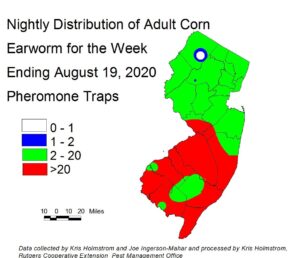 CEW pheromone trap catches have also increased across the state (see CEW pheromone map at left) with more traps now registering moderate-to-high numbers. The blacklight network is indicating a more conservative schedule in Morris, Warren and Sussex counties, while the pheromone network indicates a more conservative schedule in Salem and Cumberland counties. Areas in green on the pheromone map represent a 4-5 day schedule and red areas indicate a 3 day schedule. The number of pheromone traps deployed is much lower, resulting in much broader color bands on the map. At this time of the summer, organized storm fronts moving from west to east can result in dramatic increases in CEW in our area. This population is a serious economic threat, and it is essential that the more conservative schedule be adhered to in any given area. Further, it is important to use effective materials to manage this pest on silking corn. Insecticides in the IRAC 28 class (Coragen, Besiege, Exirel) and IRAC 5 (Radiant, Blackhawk, Entrust (OMRI approved)) remain among the most useful insecticides against CEW.
CEW pheromone trap catches have also increased across the state (see CEW pheromone map at left) with more traps now registering moderate-to-high numbers. The blacklight network is indicating a more conservative schedule in Morris, Warren and Sussex counties, while the pheromone network indicates a more conservative schedule in Salem and Cumberland counties. Areas in green on the pheromone map represent a 4-5 day schedule and red areas indicate a 3 day schedule. The number of pheromone traps deployed is much lower, resulting in much broader color bands on the map. At this time of the summer, organized storm fronts moving from west to east can result in dramatic increases in CEW in our area. This population is a serious economic threat, and it is essential that the more conservative schedule be adhered to in any given area. Further, it is important to use effective materials to manage this pest on silking corn. Insecticides in the IRAC 28 class (Coragen, Besiege, Exirel) and IRAC 5 (Radiant, Blackhawk, Entrust (OMRI approved)) remain among the most useful insecticides against CEW.
The highest nightly trap catches of CEW in pheromone traps for the week ending 8/19/20 are as follows:
| Woodstown 66 | Crosswicks 32 | Elm 17 |
| Springdale 66 | Berlin 31 | Jones Island 16 |
| Eldora 56 | Green Creek 24 | Pedricktown 16 |
| Monroeville 35 | Dayton 17 | Matawan 14 |
Silking Spray Schedules*:
South – 3 days
Central – 3 days
North – 3-4 days
*These recommendations are based on regional catches. Adhere to tighter spray schedules if indicated by local trap catches. Synthetic pyrethroids alone should NOT be used for corn earworm (CEW) protection on silking corn, or for fall armyworm (FAW) management at any stage. Control with these materials is very inconsistent.
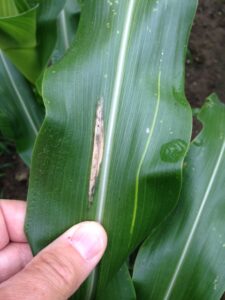 As night temperatures moderate, and dew periods lengthen, northern corn leaf blight (NCLB) will increase in frequency and severity. This fungal disease causes elongated gray streaks on leaves. The lower leaf surface will develop greenish-gray sporulation. If cooler, moist conditions persist, this disease can invade enough tissue to limit ear size. Lesions can also develop on husks, resulting in an unsightly ear. If these lesions are discovered in the pre-tassel stage or earlier, fungicide applications may be warranted. Realistic control of this disease requires a combination of protectant (mancozeb, chlorothalonil) and locally systemic fungicides in FRAC groups 3,7 and 11. For a complete list of materials, see the Sweet Corn Section of the Commercial Vegetable Production Recommendations.
As night temperatures moderate, and dew periods lengthen, northern corn leaf blight (NCLB) will increase in frequency and severity. This fungal disease causes elongated gray streaks on leaves. The lower leaf surface will develop greenish-gray sporulation. If cooler, moist conditions persist, this disease can invade enough tissue to limit ear size. Lesions can also develop on husks, resulting in an unsightly ear. If these lesions are discovered in the pre-tassel stage or earlier, fungicide applications may be warranted. Realistic control of this disease requires a combination of protectant (mancozeb, chlorothalonil) and locally systemic fungicides in FRAC groups 3,7 and 11. For a complete list of materials, see the Sweet Corn Section of the Commercial Vegetable Production Recommendations.
Pepper weevil (PW)
Another farm has been found with pepper weevil in the Berlin area. All infestations so far appear to be fairly light causing relatively little yield loss. Much of the pressure of pepper weevil will be gone by mid-September though farmers wanting to extend the season as long as possible may still continue to have problems.
As for control materials, Florida insecticide trials indicate that Actara, Vydate, Harvanta, and Torac provide the best results, however, there is a broad range of materials including pyrethroids and neonics that can kill the adults. The hope is to eliminate the weevil population before it becomes established in the field. A combination of spraying, trapping, and removal of aborted fruit would help to manage this pest.
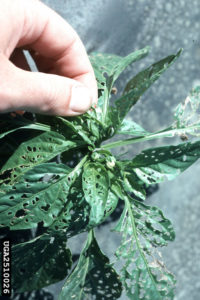 Pheromone trap catches of beet armyworm (BAW) have increased somewhat in southern NJ traps. Growers should be alert to the potential for infestation from this pest. Look for clusters of plants with lace-like damage to foliage near growing points (see photo at upper left). The green caterpillars will be found among these damaged leaves (see photo at lower left). After consuming foliage, BAW can begin to damage fruit directly. It is also important to note that BAW, like FAW, is resistant to synthetic pyrethroid insecticides. For this reason, materials in the IRAC 5 and 28 classes should be used in response to an infestation.
Pheromone trap catches of beet armyworm (BAW) have increased somewhat in southern NJ traps. Growers should be alert to the potential for infestation from this pest. Look for clusters of plants with lace-like damage to foliage near growing points (see photo at upper left). The green caterpillars will be found among these damaged leaves (see photo at lower left). After consuming foliage, BAW can begin to damage fruit directly. It is also important to note that BAW, like FAW, is resistant to synthetic pyrethroid insecticides. For this reason, materials in the IRAC 5 and 28 classes should be used in response to an infestation.
The highest nightly trap catches of BAW in pheromone traps for the week ending 8/19/20 are as follows:
| Woodstown 53 | Folsom 3 |
| Cedarville 11 | Pedricktown 2 |
| East Vineland 8 |
Pumpkins and Winter Squash
The cucurbit downy mildew (CDM) sentinel plot at Snyder Farm in Hunterdon County has CDM on cucumbers as of 8/18/2020. This plot, consisting of pumpkin, watermelon, cantaloupe, butternut, acorn, cucumber and kabocha squash is used to indicate the presence of cucurbit downy mildew in the region, and what crops are affected. As of 8/18/20, there was no CDM detected on any of the other cucurbit types, and all reported infections in our region have been on cucumber. For regional information on this important disease, see the Cucurbit Downy Mildew Forecast webpage: http://cdm.ipmpipe.org/. As of this Tuesday (8/18/20), New Jersey was rated at high risk for new infections by CDM from current regional sources.
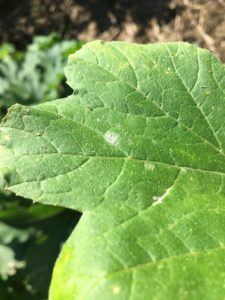
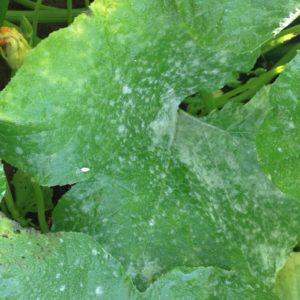 All pumpkin/gourd/winter squash fields in the scouting program have now reached the powdery mildew (PM) threshold. When scouting 50 plants (5 consecutive plants each, in 10 random locations), look within the canopy and observe the upper and lower surface of two older leaves per plant. PM generally doesn’t appear until fruit enlargement is occurring. Initial lesions will be fairly small and isolated (see photo at far left). As the disease progresses, lesions will spread out, giving the leaves a dusty appearance (see photo at near left). A PM fungicide program incorporating both protectant and locally systemic materials should be initiated when PM is found on two or more leaves in a 50 plant (100 leaf) sample. Fungicides and suggested rotations are found in the Pumpkin and Winter Squash section of the Commercial Vegetable Production Recommendations. Consider the addition of copper hydroxide to the fungicide program if bacterial leaf spot has been detected in the field.
All pumpkin/gourd/winter squash fields in the scouting program have now reached the powdery mildew (PM) threshold. When scouting 50 plants (5 consecutive plants each, in 10 random locations), look within the canopy and observe the upper and lower surface of two older leaves per plant. PM generally doesn’t appear until fruit enlargement is occurring. Initial lesions will be fairly small and isolated (see photo at far left). As the disease progresses, lesions will spread out, giving the leaves a dusty appearance (see photo at near left). A PM fungicide program incorporating both protectant and locally systemic materials should be initiated when PM is found on two or more leaves in a 50 plant (100 leaf) sample. Fungicides and suggested rotations are found in the Pumpkin and Winter Squash section of the Commercial Vegetable Production Recommendations. Consider the addition of copper hydroxide to the fungicide program if bacterial leaf spot has been detected in the field.
Tomatoes

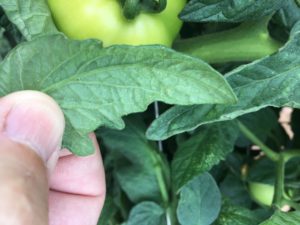 Two-spotted spider mite (TSSM) infestations continue to appear in tomato fields, with populations frequently rebounding about 2 weeks after initial control. These pests can build to high populations quickly and are a particular nuisance in high tunnels. Check two complete leaves each on 5 consecutive plants in 10 random locations in a planting. Look for the characteristic mite “stipple”, or whitish pin spots on the upper surface of the leaf (see photo at left). A check of the underside of the leaf should reveal the actual mites (photo at right). Be sure to take some samples from field or tunnel edges as this is often from where TSSM will enter the planting. Consider an miticide application if TSSM are found at more than one site in the sample. Continue to scout for TSSM, even after a control application. Miticide choices are found in the Tomato Section of the Commercial Vegetable Production Recommendations.
Two-spotted spider mite (TSSM) infestations continue to appear in tomato fields, with populations frequently rebounding about 2 weeks after initial control. These pests can build to high populations quickly and are a particular nuisance in high tunnels. Check two complete leaves each on 5 consecutive plants in 10 random locations in a planting. Look for the characteristic mite “stipple”, or whitish pin spots on the upper surface of the leaf (see photo at left). A check of the underside of the leaf should reveal the actual mites (photo at right). Be sure to take some samples from field or tunnel edges as this is often from where TSSM will enter the planting. Consider an miticide application if TSSM are found at more than one site in the sample. Continue to scout for TSSM, even after a control application. Miticide choices are found in the Tomato Section of the Commercial Vegetable Production Recommendations.
Corn earworm (tomato fruitworm) infestations have been discovered in coastal areas recently. As this pest arrives in grater numbers 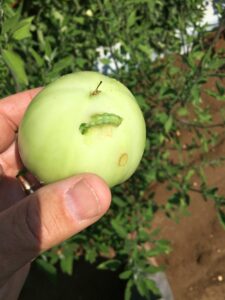 through late summer, it is important to monitor plantings for injury. Female moths lay eggs near flower clusters high on the plant. Larvae hatch and bore into fruit in the upper or outer canopy (see photo at right). If fruitworms or fresh injury are discovered in more than one scouted site, consider an insecticide application in the IRAC 5 or 28 class (see sweet corn section). Repeat applications may be necessary as long as moth counts remain high in any given area.
through late summer, it is important to monitor plantings for injury. Female moths lay eggs near flower clusters high on the plant. Larvae hatch and bore into fruit in the upper or outer canopy (see photo at right). If fruitworms or fresh injury are discovered in more than one scouted site, consider an insecticide application in the IRAC 5 or 28 class (see sweet corn section). Repeat applications may be necessary as long as moth counts remain high in any given area.
Brown Marmorated Stink Bug
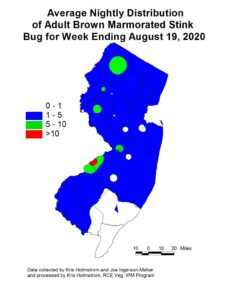 With cooler evening temperatures, brown marmorated stink bug (BMSB) activity has decreased further in blacklight traps throughout New Jersey. It is likely that these trap catches do not reflect population levels in a given area, but rather the activity of the bugs themselves. While this pest has generally declined as a threat to peppers, it remains a significant threat to tree fruit.
With cooler evening temperatures, brown marmorated stink bug (BMSB) activity has decreased further in blacklight traps throughout New Jersey. It is likely that these trap catches do not reflect population levels in a given area, but rather the activity of the bugs themselves. While this pest has generally declined as a threat to peppers, it remains a significant threat to tree fruit.
The highest nightly catches of BMSB in black light traps for the week ending 8/19/20 are as follows:
| Clinton 7 | Allentown 3 | Allamuchy 2 |
| Oldwick 5 | Bellemeade 3 | Cedarville 2 |
| Sergeantsville 5 | Cinnaminson 3 | Crosswicks 2 |
| Woodstown 4 | Hillsborough 3 | Milltown 2 |
Cole Crops
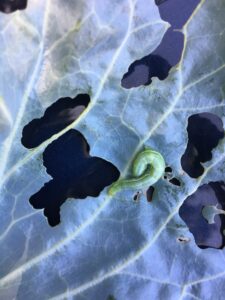 Fall plantings of cole crops are well underway at this time, and are frequently infested by imported cabbageworm (ICW) and diamondback moth (DBM) larvae. At this time, cabbage looper (CL-photo at left) and cross striped cabbage worm (CSCW-photo at right) are also causing
Fall plantings of cole crops are well underway at this time, and are frequently infested by imported cabbageworm (ICW) and diamondback moth (DBM) larvae. At this time, cabbage looper (CL-photo at left) and cross striped cabbage worm (CSCW-photo at right) are also causing injury to these crops.
injury to these crops.
Check 5 consecutive plants each in 10 random locations throughout the planting. Consider treating if caterpillars are found on 10% or more plants that are in the 0-9 true leaf stage. From 9-leaf to the early head stage (in broccoli, cauliflower, and cabbage) infestations up to 20% may be tolerated. Once heads begin to form, a 5% threshold should be observed to protect the marketable portion of the plant. For leafy greens such as collards and kale, 10% plants infested is the threshold throughout.
Some populations of DBM are resistant to carbamate and synthetic pyrethroid insecticides. The lack of DBM control with these insecticides has been noted in NJ previously. It is important to distinguish between common cole crop pests for this reason. DBM larvae grow to a length of approximately 0.5”, and taper toward both ends (see photo at right). These caterpillars thrash violently when disturbed. Newer chemistries that specifically target caterpillar pests are effective against DBM as well as all other caterpillar pests of cole crops. These materials include (active ingredient – trade name (IRAC* code)):
Spinosad/Spinetoram – Entrust(OMRI)/ Radiant (5)
Chlorantraniliprole – Coragen (28)
Cyantraniliprole – Exirel (28)
